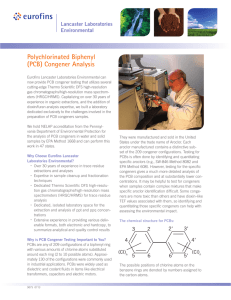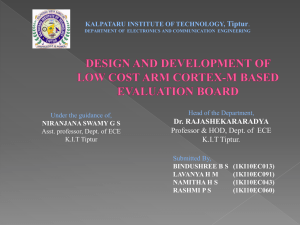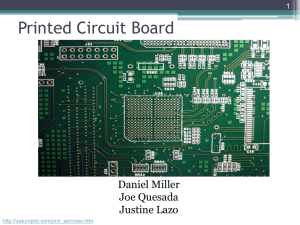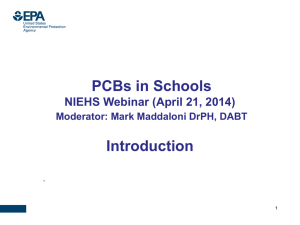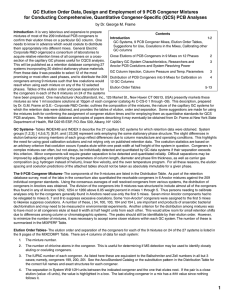HopePCB101 - Spokane River Forum
advertisement
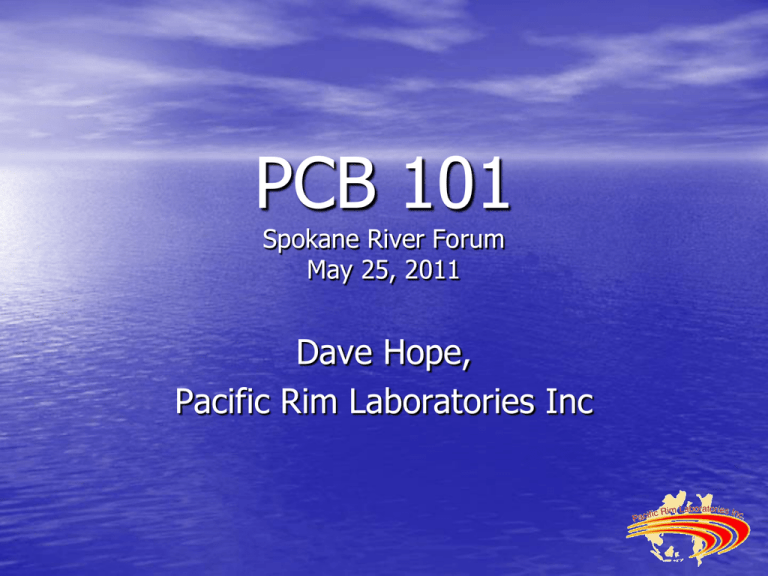
PCB 101 Spokane River Forum May 25, 2011 Dave Hope, Pacific Rim Laboratories Inc Outline • Pacific Rim Laboratories Inc. • PCB – what is it and why are we still interested • • • • • in it Toxicity How do we analyze it – Analytical Methods What does Not Detected mean? Limitations to PCB analysis Closing thoughts Who Am I? • Analytical Chemist – PChem – ACPBC – President, Canadian Council of Independent Laboratories – Owner, Lab Director Pacific Rim Laboratories • I am not – Toxicologist – Consultant Pacific Rim Laboratories Inc. • Small ultra-trace organic laboratory specializing • • • in the analysis of Persistent Organic Pollutants by High Resolution Mass Spectrometry Located in Surrey, BC (suburb of Vancouver) Accredited by WDOE, NELAC and SCC for the analysis of PCB, PCDD/F and PBDE. Work in the ppt, ppq and sub-ppq range How small is small? • $1 bill is approx. 100 cm2 • Area of Canada is 10M km2 • Finding a given dollar bill anywhere in Canada is 1 ppq (10-15) Polychlorinated Biphenyls (PCB) • Manufactured until early 1970’s (1980’s in Eastern Europe) – Total production 1.3-1.5M Tonnes – Aroclor 1016, 1242, 1254, 1260 – Kanaclor • Byproduct in the manufacture of other chemicals – Copper sulphate from China contaminated with PCB126, 169 and 77. Chemical Structure • 209 possible congeners – • mono thru decachlorobiphenyl Twelve are considered dioxin like and have been assigned Toxic Equivalency Factors (TEF) • • • • • • • • • • MonoCB DiCB TriCB TetraCB PentaCB HexaCB HeptaCB OctaCB NonaCB DecaCB 3 congeners 12 congeners 24 congeners 42 (2) congeners 46 (5) congeners 42 (4) congeners 24 (1) congeners 12 congeners 3 congeners 1 congeners PCBs on ECD – Mix of Aroclor 1242, 1254, 1260 Global Production • 48% produced • • in USA 50% of remaining prduction imported to USA 97% in Northern Hemi Applications of PCB • Closed systems • Insulation and/or cooling fluid in • • • • • • • • • transformers (48%) Dielectric fluid in capacitors (21%) Switches Partially open systems Heat transfer fluids Hydraulic fluid in lifting equipment, trucks and high pressure pumps Vacuum Pumps Voltage Regulators Liquid Filled Electrical Cables Liquid Filled Circuit Breakers • • • • • • • • • • • Open systems (21%) Paints Lubricating fluid in oils and grease Water-repellent impregnating agent and fire retardant for wood, paper, fabric and leather Laminating agent in paper production Additive in glues, sealants and corrosion protection coatings Carrier for insecticides Polymerisation catalyst support for petrochemicals Immersion oils for microscopy Pesticide Formulation Cable coatings/casings Stockholm Convention • In 2001 the Stockholm convention was adopted, restricting the manufacturing and use of twelve Persistent Organic Pollutants – POPs – PCDD/F, PCB – Pesticides – Aldrin, Dieldrin, Endrin, DDT, Heptachlor, Hexachlorobenzene, Mirex, Chlordane, Toxaphene • Ratified in May 2004 • Currently 127 countries have ratified, excluding USA • August 2010 – 9 additional chemicals included – Hexachlorocyclohexane (α, β, γ (Lindane)), PBDE (commercial Penta and Octa), hexabromobiphenyl, chlordecone, pentachlorobenzene, PFOS/PFOA – Endosulphan added last month PCB Toxicity • World Health Organization (WHO) defines twelve toxic congeners – Due to positioning of chlorines, the molecule is unable to rotate and forms structure similar to dioxin • 2,3,7,8-TCDD considered to have a toxicity of 1, all • others are relative to TCDD Toxic Equivalency Factors (TEF) – PCB126 (0.1), PCB169 (0.03), PCB077 (0.0001), PCB081 (0.0003) – PCB105, 114, 118, 123, 156, 157, 167, 189 (0.00003) • PCB TEQ = ∑Cx x TEFx for all PCB congeners Toxicity of Aroclors Congener Chlorine Number Substitution 77 Pattern (IUPAC) 3,3',4,4' 81 3,4,4',5 105 2,3,3',4,4' 114 Aroclor Composition (Wt %) A1016 A1242 Frame et al. (1996) Data A1254a A1254g A1260 0.31 0.2 0.01 0.01 0.47 7.37 2.99 2,3,4,4',5 0.04 0.5 0.18 118 2,3',4,4',5 0.66 13.59 7.35 123 2,3',4,4',5' 0.03 0.32 0.15 126 3,3',4,4',5 0.02 0.01 156 2,3,3',4,4',5 1.13 0.82 0.52 157 2,3,3',4,4',5' 0.3 0.19 0.02 167 2,3',4,4',5,5' 0.35 0.27 0.19 169 3,3',4,4',5,5' 189 2,3,3',4,4',5,5' 0.01 0.01 0.1 Toxicity trace 0.01 0.03 0.22 0.48 ppm ppm ppm ppm 0.70 27 14 0.46 Regulatory Levels – Food Max intake – 2 pg TEQ/kg bw/day • European Food Regulations (pg • • • • • • • • • • • WHO-TEQ/g fat) PCDD/F Fish (fresh wt): 4 Pork: 1 Poultry 2 Beef / mutton: 3 Liver 6 Milk: 3 Eggs: 3 Vegetable oil: 0.75 Mix Animal fat: 2 Fish oil: 2 (&PCB) (8) (1.5) (4) (4.5) (12) (6) (6) (1.5) (3) (10) • • • • • • • • European Feed Regulations Feed*: 0.75 pg WHO-TEQ/g Pet foods: 2.25 pg WHO-TEQ/g Animal fat: 2 pg WHO-TEQ/g Minerals: 1 pg WHO-TEQ/g Fish oil: 6 pg WHO-TEQ/g Fish meal: 1.25 pg WHO-TEQ/g * - based on 12% moisture content Food levels • Eggs – 2.1-38 ug/kg fat – 0.11 – 2.86 ng TEQ/kg fat • Meat – 50 – 1960 ng/kg fat – 0.001 – 0.182 ng TEQ/kg fat • Fish 0.29 – 87 ug/kg – 0.1 – 2.4 ng TEQ/kg Fish sample – Cl4-Cl7 70 52 74 66 60 110 118 105 153 138 128 182/187 156 180 170 Fish sample – Cl7-Cl10 180 170 199 203 194 206 209 PCB Analysis in Blood tetra-PCBs • PCBs in blood – 200-800 ug /kg lipid – PCB153>138>180>18 7>118>170>99 penta-PCBs hexa-PCBs 20 Analytical Methods Good – Better - Best • GC/ECD Methods – EPA 8081, 8082, 608, 508 • GC/MS Methods – EPA 8270 • GC/HRMS Methods – EPA 1668 Analytes Good – Better - Best • Total PCB – Aroclor equivalents • Homolog Totals – 10 levels of chlorination • Congener specific (209) Sample Extraction & Clean-up • Extraction – Water – liquid/liquid extraction – Soil – soxhlet – Tissue – acid digestion followed by liquid/liquid extraction • Clean-up – Wash with conc. Sulfuric acid – Column on acidic silica gel – Column on basic alumina Quantitation Methods Good – Better - Best • External standard – compare with calibration curve – Requires known final volume and amount injected • Internal Standard – Add standard just before analysis – Relative response factors determined from calibration curve – With area of IS peak and RRF, can calculate concentration • Isotope dilution – Stable isotopes added before extraction used to quantify results – Corrects for loses during work-up EPA 8082 • Can be used to identify Aroclors or congeners • 19 congeners – MonoCB – NonaCB • PCB1, 15, 18, 31, 44, 52, 66, 87, 101, 110, 138, 141, • 151, 153, 170, 180, 183, 187, 206 IS Method: One internal standard and one surrogate standard Pattern Recognition • Must match the pattern • • • in the sample with one of 7 Aroclor standards Use 3-5 peaks in the standard to quantify sample (External Std) Detection limits 0.05 ug/L Problems with pattern recognition in weathered samples GC/MS Methods • EPA 8270 – Generic catch-all method – Uses GC/MS for ultimate identification, but causes a greatly reduced sensitivity (increased detection limit) – Detection limits 10 ug/L (Aroclor equivalents) • Homolog Total Methods – Uses GC/MS in SIM for greater sensitivity and selectivity – Internal Standard for each level of chlorination – PCB defined as having peaks in QM and RM channels and being within 15% of theoretical mass ratio – Quantifies on congener basis but not identified – Detection limits 0.001 ug/L on a congener basis EPA Method 1668 • HRGC-HRMS congener specific method (first written • 1999, revised in November 2008, June 2010) Uses 27 internal standards (13C12-labeled congeners) – All twelve dioxin-like PCBs – First and last eluters in each level of chlorination (LOC) – Three 13C12-clean-up standards and five 13C12-recovery standards • Five (1-2000 ng/mL) or six point (0.2-2000 ng/mL) • • calibration for dlPCBs and LOC PCBs Single point calibration for all remaining PCBs Two methods of quantification – Isotope dilution (for 27 congeners with labeled standards) – Internal standard – everything else HRMS analysis - Issues • Coelutions for TeCB, PeCB and HxCB – M-Cl gives significant peak, therefore cannot have coelutions with significant peaks of higher LOC • Each LOC requires four ions – PeCB, HxCB, HpCB and OcCB overlap – Requires 16 ion channels • Need to maximize sensitivity, therefore typical collection rates of 1 hz (no 10-100 hz that can be found with ECDs or MSDs) GC Columns • 1668 is based on SPB-octyl column, or dual column with • DB-1. Has been met with mixed reviews. Resolves 159 peaks (180 with DB-1) – – – – 30/42 TeCB 29/46 PeCB 31/42 HxCB PCB156 and 157 coelute • DB-5ms is another popular column • Performance specs similar to Octyl (165 peaks) however separates 156 & 157 New column – SGE HT8 PCB • 8% Phenyl (equiv.) Polycarborane-siloxane • 60 m column, 0.25 mm i.d, – – – – – Initial Temp 90 C for 1 min. Ramp 20 C/min -> 190 C Ramp2 1.5 C/min. -> 250 C Ramp3 4.0 C/min. -> 300 C Final Temp 300 C for 4.2 min. • Thermo DFS HRMS with dual Thermo Trace GCs, split/splitless injection Results • 209 resolvable by ECD @ 100 hz • 189 resolvable peak tops by HRMS • 37/42 TeCB • 37/46 PeCB • 40/42 HxCB C o ng en N umb er 9 Pt St d C S2 0 9 PCB-001 PCB-002 PCB-003 10.44 13.02 13.30 10.29 12.94 13.23 PCB-010 PCB-004 PCB-009 PCB-007 PCB-006 PCB-008 PCB-005 PCB-014 PCB-011 PCB-013 PCB-012 PCB-015 14.18 14.29 16.35 16.60 17.78 18.31 18.39 19.95 22.45 23.17 23.19 46.47 14.04 14.22 16.31 16.49 17.76 PCB-019 PCB-030 PCB-018 PCB-017 PCB-024 PCB-027 PCB-032 PCB-016 PCB-023 PCB-034 PCB-029 PCB-026 PCB-025 PCB-031 PCB-028 PCB-021 PCB-020 PCB-033 PCB-022 PCB-036 PCB-039 PCB-038 PCB-035 PCB-037 19.56 20.41 22.27 22.67 23.24 23.75 24.66 24.90 25.95 26.41 26.61 27.56 27.99 28.50 29.03 29.98 30.55 30.59 31.49 32.70 33.78 35.41 37.36 38.64 18.30 19.88 22.47 23.16 23.96 19.50 20.38 22.25 22.61 23.21 23.73 24.62 24.88 25.95 26.39 26.59 27.54 27.98 28.49 29.03 29.99 30.56 31.51 32.73 33.85 35.43 37.43 38.72 C o ng en N umb er 9 Pt St d C S2 0 9 PCB-054 PCB-050 PCB-053 PCB-051 PCB-045 PCB-046 PCB-069 PCB-052 PCB-073 PCB-043 PCB-049 PCB-065 PCB-075 PCB-062 PCB-048 PCB-047 PCB-044 PCB-059 PCB-042 PCB-064 PCB-072 PCB-071 PCB-041 PCB-068 PCB-040 PCB-057 PCB-067 PCB-063 PCB-058 PCB-061 PCB-074 PCB-070 PCB-055 PCB-066 PCB-080 PCB-076 PCB-060 PCB-056 PCB-079 PCB-078 PCB-081 PCB-077 25.37 27.37 28.95 29.71 30.56 32.09 32.90 33.01 33.27 33.45 33.68 33.95 34.23 34.39 34.35 34.40 36.33 36.56 36.98 37.85 38.27 38.28 38.37 39.08 39.81 40.37 41.32 41.69 41.92 42.18 42.73 43.54 43.78 44.36 44.37 45.58 46.94 47.22 49.75 51.27 52.51 54.16 25.37 27.35 28.98 29.73 30.56 32.09 33.01 33.31 33.68 33.94 34.27 34.38 36.35 36.59 36.99 37.86 38.18 38.33 39.11 39.83 40.40 41.35 41.73 41.93 42.20 42.78 43.59 43.78 44.39 44.49 45.61 47.00 47.26 49.84 51.36 52.59 54.20 C o ng en N umb er 9 Pt St d C S2 0 9 PCB-104 PCB-096 PCB-103 PCB-100 PCB-094 PCB-093 PCB-102 PCB-098 PCB-095 PCB-088 PCB-091 PCB-121 PCB-084 PCB-092 PCB-089 PCB-090 PCB-101 PCB-113 PCB-099 PCB-112 PCB-119 PCB-083 PCB-109 PCB-086 PCB-125 PCB-117 PCB-097 PCB-116 PCB-115 PCB-087 PCB-111 PCB-085 PCB-110 PCB-120 PCB-082 PCB-124 PCB-108 PCB-107 PCB-123 PCB-106 PCB-118 PCB-114 PCB-122 PCB-105 PCB-127 PCB-126 33.92 37.12 38.48 39.55 40.55 41.75 41.89 41.96 42.11 42.55 43.15 43.69 45.76 45.98 46.18 46.84 47.17 47.65 48.10 49.10 49.34 49.59 49.73 50.31 50.43 50.48 50.63 50.87 51.11 51.19 51.78 51.91 52.60 52.68 54.02 55.49 55.81 55.84 56.14 56.28 56.59 57.27 57.87 59.08 59.26 61.33 33.90 37.15 38.50 39.55 40.59 41.81 42.59 43.15 43.73 45.80 45.99 46.22 46.88 47.19 47.68 48.12 49.12 49.72 49.72 50.48 50.91 51.16 51.89 51.99 52.65 52.73 54.05 55.51 55.86 56.15 56.30 56.61 57.29 57.91 59.09 59.28 61.36 C o ng en N umb er PCB-155 PCB-150 PCB-152 PCB-145 PCB-136 PCB-148 PCB-154 PCB-151 PCB-135 PCB-144 PCB-147 PCB-149 PCB-139 PCB-140 PCB-143 PCB-134 PCB-142 PCB-131 PCB-133 PCB-165 PCB-132 PCB-146 PCB-161 PCB-153 PCB-168 PCB-141 PCB-137 PCB-130 PCB-163 PCB-164 PCB-138 PCB-160 PCB-158 PCB-129 PCB-166 PCB-159 PCB-128 PCB-162 PCB-167 PCB-156 PCB-157 PCB-169 9 Pt St d C S2 0 9 43.35 46.70 47.77 50.01 50.05 50.58 51.88 52.99 53.51 53.73 53.80 54.56 54.59 55.08 55.41 55.61 56.03 56.25 56.70 57.25 57.45 57.50 57.78 58.29 58.39 59.06 59.51 59.70 60.06 60.07 60.19 60.21 60.37 60.53 60.79 61.47 61.59 61.74 62.09 62.98 63.17 64.43 43.37 46.70 47.77 48.99 50.06 50.58 51.89 52.99 53.52 53.87 53.81 54.59 55.10 55.43 55.63 56.02 56.27 56.70 57.25 57.50 57.50 57.78 58.32 58.39 59.08 59.52 59.70 60.08 60.21 60.31 60.39 60.53 60.79 61.49 61.61 61.76 62.09 62.97 63.17 64.46 C o ng en N umb er 9 Pt St d C S2 0 9 PCB-188 PCB-184 PCB-179 PCB-176 PCB-186 PCB-178 PCB-175 PCB-182 PCB-187 PCB-183 PCB-185 PCB-174 PCB-181 PCB-177 PCB-171 PCB-173 PCB-172 PCB-192 PCB-180 PCB-193 PCB-191 PCB-170 PCB-190 PCB-189 55.30 56.25 57.48 58.31 58.91 59.98 60.39 60.54 60.56 60.94 61.38 61.66 61.74 61.90 62.19 62.40 62.99 63.13 63.32 63.35 63.55 64.24 64.35 65.67 55.31 56.27 57.50 58.31 58.93 60.00 60.41 PCB-202 PCB-200 PCB-204 PCB-197 PCB-201 PCB-198 PCB-199 PCB-196 PCB-203 PCB-195 PCB-194 PCB-205 61.42 61.85 61.97 62.26 62.79 64.05 64.10 64.37 64.41 65.37 66.60 66.96 61.45 61.87 61.97 62.27 62.81 64.08 64.13 64.39 64.43 65.36 66.60 66.95 PCB-208 PCB-207 PCB-206 64.69 65.04 67.59 64.72 65.05 67.59 PCB-209 68.05 68.05 60.56 60.95 61.38 61.66 61.74 61.89 62.20 62.40 62.99 63.14 63.35 63.45 63.57 64.24 64.38 65.68 What is the Detection Limit? • Standard methods for MDL determination – – – – 7-10 blank samples spiked at low level with analytes of interest MDL = 3 * SD (approximately) Better precision leads to low MDLs Our MDLs are 1-13 pg/L • Isotope dilution allows for lower theoretical MDLs due to • • lower SD Many isotope dilution methods call for the reporting of Instrument Detection Limits based on 2.5 x SN Can give IDLs <1 pg/L Analyte PCB # Blank n t pg/L Average Stdev (s) pg/L pg/L RSD Recovery MDL (ts) pg/L 2-MoCB 1 3.80 9 2.896 12.06 2.00 17% 165% 6.0 2,4'-DiCB 8 7.89 9 2.896 21.15 2.40 11% 265% 7.5 2,2',6-TriCB 19 9 2.896 8.10 0.62 8% 162% 1.8 2,2',5-TriCB 18 9 2.896 9.86 3.00 30% 197% 9 2,4,4'-TriCB 28 9 2.896 17.63 4.13 23% 142% 12 2,2',5,5'-TeCB 52 9 2.896 4.93 1.94 39% 99% 5.8 3,4,4',5-TeCB 81 9 2.896 5.68 0.45 8% 114% 1.3 3,3',4,4'-TeCB 77 9 2.896 6.54 0.25 4% 131% 0.75 2,2',4,5,5'-PeCB 101 2.19 9 2.896 9.03 1.81 20% 137% 5.4 2,2',4,4',5-PeCB 99 1.38 9 2.896 6.22 1.22 20% 97% 3.7 2,3,3',4',6-PeCB 110 6.17 9 2.896 11.01 2.07 19% 97% 6.2 2,3',4,4',5'-PeCB 123 9 2.896 5.48 0.47 9% 110% 1.4 2,3',4,4',5-PeCB 118 9 2.896 9.36 0.99 11% 121% 3.0 2,3,4,4',5-PeCB 114 9 2.896 5.61 0.37 7% 112% 1.1 2,3,3',4,4'-PeCB 105 9 2.896 7.17 0.50 7% 81% 1.5 3,3',4,4',5-PeCB 126 9 2.896 4.99 0.47 9% 100% 1.4 2,2',3,4',5',6-HxCB 149 9 2.896 20.08 4.11 20% 206% 13 2,2',3,4,5,5'-HxCB 141 9 2.896 4.71 0.47 10% 94% 1.4 2,2',3,3',4,5-HxCB 138 9 2.896 10.00 1.38 14% 180% 4.1 2,3',4,4',5,5'-HxCB 167 9 2.896 5.28 0.56 11% 106% 1.7 2,3,3',4,4',5-HxCB 156 9 2.896 5.59 0.42 7% 112% 1.3 2,3,3',4,4',5'-HxCB 157 9 2.896 5.47 0.46 8% 109% 1.4 3,3',4,4',5,5'-HxCB 169 9 2.896 4.35 0.46 10% 87% 1.4 2,2',3,3',4,4',6-HpCB 171 9 2.896 9.60 1.30 13% 192% 3.9 2,3,3',4,4',5,5'-HpCB 189 9 2.896 5.54 0.41 7% 111% 1.2 2,2',3,3',5,5',6,6'-OcCB 202 9 2.896 5.54 0.60 11% 111% 1.8 2,2',3,3',4,5',6,6'-OcCB 201 9 2.896 3.66 0.34 9% 73% 1.0 2,2',3,3',4,4',5,5',6-NoCB 206 9 2.896 5.63 0.64 11% 113% 1.9 2,2',3,3',4,4',5,5',6,6'-DeCB 209 9 2.896 6.66 1.14 17% 133% 3.4 10.54 3.33 3.10 9.76 1.02 IUPAC Name PCB # CAS # Conc. IDL 2-MoCB PCB-001 2051-60-7 3-MoCB PCB-002 4-MoCB PCB-003 2,6-DiCB pg/L pg/L 9.9 0.8 J 2051-61-8 5.6 0.8 J 2051-62-9 3.2 0.8 J PCB-010 33146-45-1 3.7 3.7 UJ 2,2'-DiCB PCB-004 13029-08-8 30.2 3.7 2,5-DiCB PCB-009 34883-39-1 3.7 3.7 UJ 2,4-DiCB PCB-007 33284-50-3 3.7 3.7 UJ 2,3'-DiCB PCB-006 25569-80-6 3.7 3.7 UJ 2,3/2,4'-DiCB PCB-005/008 7.2 3.7 J 3,5-DiCB PCB-014 34883-41-5 3.7 3.7 UJ 3,3'-DiCB PCB-011 2050-67-1 44.4 3.7 3,4/3,4'-DiCB PCB-012/013 3.7 3.7 4,4'-DiCB PCB-015 2050-68-2 4.3 3.7 J 2,2',6-TrCB PCB-019 38444-73-4 0.9 0.9 UJ 2,4,6-TrCB PCB-030 35693-92-6 0.9 0.9 UJ 2,2',5-TrCB PCB-018 37680-65-2 12.6 0.9 2,2',4-TrCB PCB-017 37680-66-3 5.4 0.9 J 2,3,6-TrCB PCB-024 55702-45-9 0.9 0.9 UJ 2,3',6-TrCB PCB-027 38444-76-7 0.9 0.9 UJ 2,4',6-TrCB PCB-032 38444-77-8 0.9 0.9 UJ 2,2',3-TrCB PCB-016 38444-78-9 4.4 0.9 J 2,3,5-TrCB PCB-023 55720-44-0 0.9 0.9 UJ 2,3',5'-TrCB PCB-034 37680-68-5 0.9 0.9 UJ 2,4,5-TrCB PCB-029 15862-07-4 0.9 0.9 UJ 2,3',5-TrCB PCB-026 38444-81-4 0.9 0.9 UJ 2,3',4-TrCB PCB-025 55712-37-3 0.9 0.9 UJ 2,4',5-TrCB PCB-031 16606-02-3 8.6 0.9 J 2,4,4'-TrCB PCB-028 7012-37-5 6.8 0.9 J 2,3,4-TrCB PCB-021 55702-46-0 0.9 0.9 UJ 4.7 0.9 J PCB-020/033 Flag UJ 2,3,4'-TrCB PCB-022 38444-85-8 0.9 0.9 UJ 3,3',5-TrCB PCB-036 38444-87-0 0.9 0.9 UJ 3,4',5-TrCB PCB-039 38444-88-1 0.9 0.9 UJ 3,4,5-TrCB PCB-038 53555-66-1 0.9 0.9 UJ 3,3',4-TrCB PCB-035 37680-69-6 0.9 0.9 UJ 3,4,4'-TrCB PCB-037 38444-90-5 0.9 0.9 UJ • Values >IDL are real • Values between IDL and MDL??? What is Total PCB? • Sounds simple, add up individual results for all 209 congeners • How do you handle different detection limits? Co-elutions? Low level concentrations? • Should data be reported below EQL? PCB # A B C D E Blank Homologs pg/L pg/L pg/L pg/L pg/L pg/L Monochlorobiphenyls 10.8 10 12.3 10.7 11 0 Dichlorobiphenyls 19.6 74.6 50.5 52 14.4 0 Trichlorobiphenyls 63 12.6 0 11.3 0 0 Tetrachlorobiphenyls 101 0 10.4 0 0 0 Pentachlorobiphenyls 152 23.2 15.5 27.6 0 29.9 Hexachlorobiphenyls 69.2 0 0 0 0 0 Heptachlorobiphenyls 0 0 0 0 0 0 Octachlorobiphenyls 0 0 0 0 0 0 Nonachlorobiphenyls 0 0 0 0 0 0 Decachlorobiphenyl 0 0 0 0 0 0 415 110 88.7 102 25.4 Total PCB 29.9 PCB # A B C D E Blank Homologs pg/L pg/L pg/L pg/L pg/L pg/L Monochlorobiphenyls 14.5 18.7 18.5 20.1 17.6 9.3 Dichlorobiphenyls 19.6 86.1 50.5 52 14.4 0 Trichlorobiphenyls 88.2 42.5 31.5 36 34.7 0 Tetrachlorobiphenyls 132.8 29.5 33.6 37.7 24.4 0 Pentachlorobiphenyls 173.4 40.2 24 27.6 15.5 29.9 Hexachlorobiphenyls 119.3 9.2 14.5 4.6 5.6 1.8 Heptachlorobiphenyls 30.2 0 0 0 2.3 0 Octachlorobiphenyls 11.6 0 2.5 0 1.4 0 Nonachlorobiphenyls 0 0 0 0 0 0 Decachlorobiphenyl 4.4 0 0 0 0 0 Total PCB 594 226.2 175.1 178 115.9 41 A B C D E Blank Homologs pg/L pg/L pg/L pg/L pg/L pg/L Monochlorobiphenyls 10.8 10 12.3 10.7 11 0 Dichlorobiphenyls 19.6 74.6 50.5 52 14.4 0 Trichlorobiphenyls 63 12.6 0 11.3 0 0 Tetrachlorobiphenyls 101 0 10.4 0 0 0 Pentachlorobiphenyls 152 23.2 15.5 27.6 0 29.9 Hexachlorobiphenyls 69.2 0 0 0 0 0 Heptachlorobiphenyls 0 0 0 0 0 0 Octachlorobiphenyls 0 0 0 0 0 0 Nonachlorobiphenyls 0 0 0 0 0 0 Decachlorobiphenyl 0 0 0 0 0 0 415 110 88.7 102 25.4 29.9 PCB # Total PCB What is Blank? • • • • PCB is omnipresent Almost impossible to achieve a complete blank in the lab Every sample we analyze has detectable PCB levels. In order to reduce blank levels in the lab – Use carbon filtered water – Disposable glassware (not always possible) – Keep food samples away! • <20 pg/L per congener is excellent What is achievable? • Less than 20 labs in North America can run EPA 1668 • No analytical confidence at 3 pg/L for Total PCB • Reductions will be hard to measure – Are they lab caused or real? • Focus on Toxic PCBs rather than 209 congeners Thank you! dave@pacificrimlabs.com www.pacificrimlabs.com


